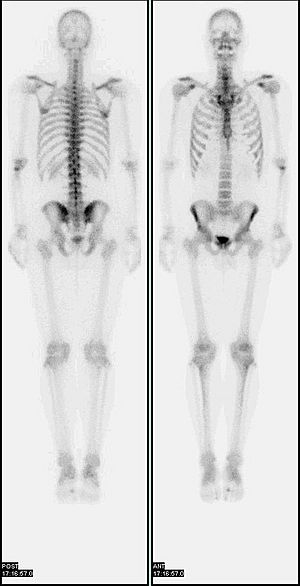Nuclear medicine facts for kids
Nuclear medicine is a special part of medicine that uses tiny amounts of radioactive substances to help doctors understand what's happening inside your body. It's used to find out if you have a disease and sometimes even to treat it.
Think of it like "inside-out radiology." Instead of using X-rays that go through your body from the outside, nuclear medicine looks at radiation that comes from inside your body. This radiation is given off by special substances you take, which then travel to specific parts of your body.
Contents
What is Nuclear Medicine?
Nuclear medicine is a unique way doctors can see inside your body and understand how your organs are working. Unlike X-rays, CT scans, or MRI scans that mostly show the structure of your body (like bones or organs), nuclear medicine shows how your body parts are actually functioning. This means it can find problems earlier than other tests.
How Does Nuclear Medicine Work?
Nuclear medicine uses something called a "radiotracer" or "radioactive tracer." This is a special substance that has a very small amount of radioactive material attached to it. When you take this tracer, it travels to specific organs, bones, or tissues in your body.
Getting the Tracer into Your Body
You might receive the radiotracer in a few ways:
- Injection: Most often, it's injected into a vein in your arm.
- Swallowing: Sometimes, you might swallow it as a pill or liquid.
- Breathing: In some cases, you might breathe it in as a gas.
How Machines See the Tracer
Once the tracer is inside your body, it gives off tiny amounts of energy called gamma rays. Special cameras, like a "gamma camera" or a "PET scanner," can detect these gamma rays. The camera then creates pictures that show where the tracer has gone in your body. These pictures help doctors see how well your organs are working or if there are any unusual areas.
What is Nuclear Medicine Used For?
Nuclear medicine is used for many different reasons, both to find problems (diagnosis) and to treat them.
Finding Health Problems
Doctors use nuclear medicine scans to help diagnose many conditions. Here are some common uses:
- Bone Scans: These scans can find problems with your bones, like stress fractures, infections, or if cancer has spread to the bones.
- Heart Scans: They can check how well blood is flowing to your heart muscle and if there's any damage after a heart attack.
- Thyroid Scans: These scans help check if your thyroid gland is working correctly or if there are any unusual growths.
- Brain Scans: They can help doctors study blood flow to the brain and look for certain brain disorders.
- Kidney Scans: These scans can check how well your kidneys are filtering waste from your blood.
- Cancer Detection: Nuclear medicine is very good at finding cancer cells in the body and seeing if cancer has spread.
Treating Health Problems
Sometimes, nuclear medicine can also be used for treatment. This is called "radiopharmaceutical therapy." In these cases, the radioactive substance is designed to go directly to diseased cells, like cancer cells, and destroy them while causing less harm to healthy cells.
For example, radioactive iodine can be used to treat certain types of thyroid cancer or an overactive thyroid gland. The thyroid cells absorb the iodine, and the radiation then helps to destroy the problem cells.
Is Nuclear Medicine Safe?
Yes, nuclear medicine is considered very safe. The amount of radioactive material used is very small, and it leaves your body quickly, usually within a few hours or days. The benefits of finding or treating a serious health problem usually outweigh the very small risks from the radiation. Doctors and technicians who perform these tests are highly trained to ensure your safety.
Images for kids
See also
 In Spanish: Medicina nuclear para niños
In Spanish: Medicina nuclear para niños



